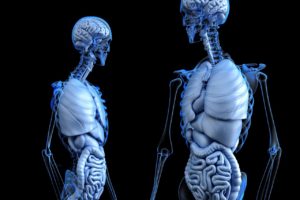Reflux vs Ulcer [Show Notes]

Gastro-Esophageal Reflux Disorder
GERD, or just Reflux.
Reflux is a word that is used to describe something in your body that flows backwards. The fluids in your body have a certain direction they naturally flow for your body to work properly. If they start flowing backwards, it’s called reflux, and can lead to problems.
Is that like heartburn?
Yes, heartburn is a type of mild reflux. Something (like a certain type of food or overeating) causes the stomach acid to bubble back up into the esophagus.
Overeating or other physiological disorder can cause the lower sphincter to not close tightly or completely.
Ulcer
They lining of your stomach produces the acid, thus it’s intended to be resistant against the acid. The lining of the esophagus is not intended to handle that acid. And stomach acid is way more acidic that our saliva or acidic foods that we may eat.
Now, if the acid-producing (and acid-resistant) lining of the stomach wall gets injured, and the layers underneath come in contact with the acid, it causes pain.
Would that cause someone to throw up blood?
Yes, it possibly would. Any tissue that is living and working in your body, requires a blood supply to bring in nutrients and carry out waste. So, the walls of your stomach is full of blood vessels. If the acid, eats through the layers and gets to the blood vessels, that blood will spill into the stomach. Unfortunately, your digestive system isn’t intended to digest large amounts of blood. The pain from the acid plus the large amounts of blood can lead to nausea and vomiting.
How I assess ulcer or reflux
Where does it hurt?
– Reflux: in the esophagus or throat (even to the point of hoarseness)
– Ulcer: Stomach
Does it hurt worse when you’re hungry or after you eat?
– Reflux: hurts after food has gone into stomach or you lay down at night because you don’t have gravity holding the acid down into the stomach.
– Ulcer: hurts when the stomach is empty because the acid only comes in contact with the stomach lining, rather than having food to work on.
Treatment
The treatment for both is the same. The goal for both is to reduce the acid production. People will try to self-treat by taking tons and tons of OTC antacids (liquid or tablets). Antacids are bases, so they goal is to neutralize the acids, but once that amount has moved into the intestines, the base is gone and the acid is till there. Other acid reduces are OTC as well. Histamine 2 Receptor Blockers (Pepcid, Zantac) can start to work within 30 minutes. Proton Pump Inhibitors (Prilosec, Prevacid, Nexium) can take up to 2 weeks to reduce the acid, so not intended for instant treatment.
Bottom Line
Whether it’s ulcers or reflux, your doctor needs to know what’s going on so they can monitor your progress. Anything that manipulates cells in your body (whether stomach cells damaged in an ulcer or esophageal cells being corroded by acid) can cause cellular changes that may become cancer.
Connect with me
Support us on Patreon
*NEW* Join the Pharmacist Answers Podcast Community on Facebook
Subscribe: iTunes, Stitcher, GooglePlay, TuneIn Radio
Music Credits: “Radio Martini” Kevin MacLeod (incompetech.com) Licensed under Creative Commons: By Attribution 3.0 http://creativecommons.org/licenses/by/3.0/

